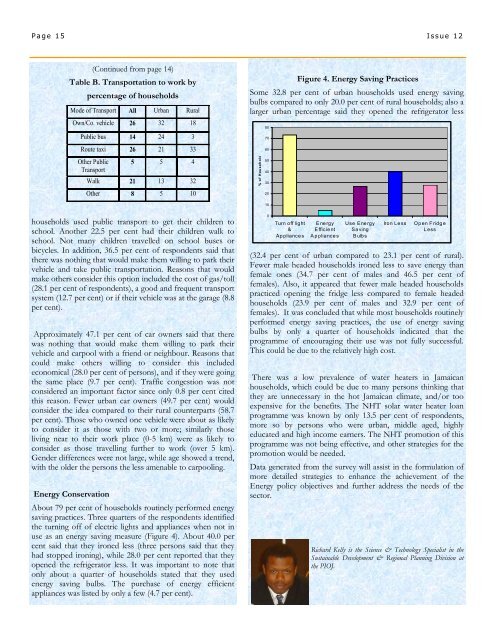Beginnings Issue 12.pub - Planning Institute of Jamaica
Beginnings Issue 12.pub - Planning Institute of Jamaica
Beginnings Issue 12.pub - Planning Institute of Jamaica
You also want an ePaper? Increase the reach of your titles
YUMPU automatically turns print PDFs into web optimized ePapers that Google loves.
P a g e 15 I s s u e 12<br />
(Continued from page 14)<br />
Table B. Transportation to work by<br />
percentage <strong>of</strong> households<br />
Mode <strong>of</strong> Transport All Urban Rural<br />
Own/Co. vehicle 26 32 18<br />
Public bus 14 24 3<br />
Route taxi 26 21 33<br />
Other Public<br />
Transport<br />
5 5 4<br />
Walk 21 13 32<br />
Other 8 5 10<br />
Figure 4. Energy Saving Practices<br />
Some 32.8 per cent <strong>of</strong> urban households used energy saving<br />
bulbs compared to only 20.0 per cent <strong>of</strong> rural households; also a<br />
larger urban percentage said they opened the refrigerator less<br />
% o f Hou seh o ld s<br />
80<br />
70<br />
60<br />
50<br />
40<br />
30<br />
20<br />
10<br />
households used public transport to get their children to<br />
school. Another 22.5 per cent had their children walk to<br />
school. Not many children travelled on school buses or<br />
bicycles. In addition, 36.5 per cent <strong>of</strong> respondents said that<br />
there was nothing that would make them willing to park their<br />
vehicle and take public transportation. Reasons that would<br />
make others consider this option included the cost <strong>of</strong> gas/toll<br />
(28.1 per cent <strong>of</strong> respondents), a good and frequent transport<br />
system (12.7 per cent) or if their vehicle was at the garage (8.8<br />
per cent).<br />
Approximately 47.1 per cent <strong>of</strong> car owners said that there<br />
was nothing that would make them willing to park their<br />
vehicle and carpool with a friend or neighbour. Reasons that<br />
could make others willing to consider this included<br />
economical (28.0 per cent <strong>of</strong> persons), and if they were going<br />
the same place (9.7 per cent). Traffic congestion was not<br />
considered an important factor since only 0.8 per cent cited<br />
this reason. Fewer urban car owners (49.7 per cent) would<br />
consider the idea compared to their rural counterparts (58.7<br />
per cent). Those who owned one vehicle were about as likely<br />
to consider it as those with two or more; similarly those<br />
living near to their work place (0-5 km) were as likely to<br />
consider as those travelling further to work (over 5 km).<br />
Gender differences were not large, while age showed a trend,<br />
with the older the persons the less amenable to carpooling.<br />
Energy Conservation<br />
About 79 per cent <strong>of</strong> households routinely performed energy<br />
saving practices. Three quarters <strong>of</strong> the respondents identified<br />
the turning <strong>of</strong>f <strong>of</strong> electric lights and appliances when not in<br />
use as an energy saving measure (Figure 4). About 40.0 per<br />
cent said that they ironed less (three persons said that they<br />
had stopped ironing), while 28.0 per cent reported that they<br />
opened the refrigerator less. It was important to note that<br />
only about a quarter <strong>of</strong> households stated that they used<br />
energy saving bulbs. The purchase <strong>of</strong> energy efficient<br />
appliances was listed by only a few (4.7 per cent).<br />
0<br />
Turn <strong>of</strong>f light<br />
&<br />
Ap pliance s<br />
E ne rgy<br />
E fficie nt<br />
A p pliance s<br />
Use Ene rgy<br />
Sa ving<br />
B ulb s<br />
Iron Le ss<br />
Op en F ridg e<br />
L ess<br />
(32.4 per cent <strong>of</strong> urban compared to 23.1 per cent <strong>of</strong> rural).<br />
Fewer male headed households ironed less to save energy than<br />
female ones (34.7 per cent <strong>of</strong> males and 46.5 per cent <strong>of</strong><br />
females). Also, it appeared that fewer male headed households<br />
practiced opening the fridge less compared to female headed<br />
households (23.9 per cent <strong>of</strong> males and 32.9 per cent <strong>of</strong><br />
females). It was concluded that while most households routinely<br />
performed energy saving practices, the use <strong>of</strong> energy saving<br />
bulbs by only a quarter <strong>of</strong> households indicated that the<br />
programme <strong>of</strong> encouraging their use was not fully successful.<br />
This could be due to the relatively high cost.<br />
There was a low prevalence <strong>of</strong> water heaters in <strong>Jamaica</strong>n<br />
households, which could be due to many persons thinking that<br />
they are unnecessary in the hot <strong>Jamaica</strong>n climate, and/or too<br />
expensive for the benefits. The NHT solar water heater loan<br />
programme was known by only 13.5 per cent <strong>of</strong> respondents,<br />
more so by persons who were urban, middle aged, highly<br />
educated and high income earners. The NHT promotion <strong>of</strong> this<br />
programme was not being effective, and other strategies for the<br />
promotion would be needed.<br />
Data generated from the survey will assist in the formulation <strong>of</strong><br />
more detailed strategies to enhance the achievement <strong>of</strong> the<br />
Energy policy objectives and further address the needs <strong>of</strong> the<br />
sector.<br />
Richard Kelly is the Science & Technology Specialist in the<br />
Sustainable Development & Regional <strong>Planning</strong> Division at<br />
the PIOJ.
















